Samsung Fascinate Review: Verizon's Galaxy S Smartphone
by Brian Klug on October 5, 2010 12:01 AM EST- Posted in
- Smartphones
- Samsung
- Galaxy S
- Fascinate
- Mobile
Performance
Anand declared the Epic 4G the fastest Android phone. I think it's safe to say that right now the Galaxy S is the undisputed performance champ for 3D, at least until we start seeing SoCs built around A9 MPCore with even more powerful GPUs. CPU wise, Hummingbird is running the same architecture ARM Cortex A8 at 1 GHz that we've seen in other SoCs. For now, the Fascinate's Hummingbird SoC with the PowerVR SGX 540 GPU is really what sets it apart. It's a significant improvement over the SGX 530/535, and if you haven't already, I'd encourage you to read what Anand had to say about it in the Epic review.
That improvement is readily apparent in Quake III, where the Fascinate posts unsurprisingly similar numbers to the Epic.
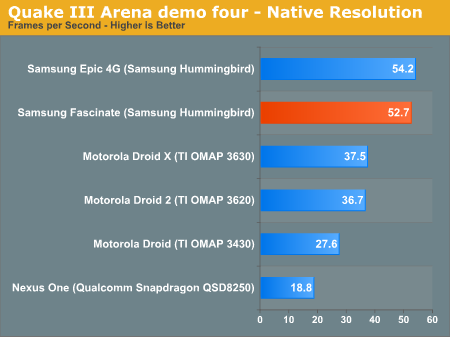
Likewise, we get similarly impressive Neocore numbers out of the Fascinate, which is Qualcomm's benchmark for showing off Adreno.
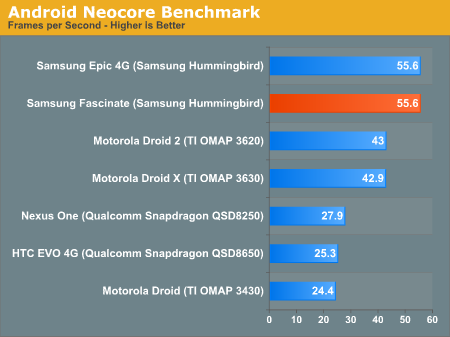
Though most of Android still can't take advantage of the SGX 540, applications that are rendered using OpenGL do show a massive performance boost. The qualitative difference between the stock Android gallery application on the Nexus One compared to the Fascinate is huge. On the Nexus One, it feels occasionally slow and choppy, yet on the Fascinate it's beyond smooth.
When the Android UI finally gets GPU acceleration, that huge performance gain will be readily apparent in everyday use instead of locked away for 3D apps and games.
Of course, our CPU-bound tests show almost exactly what you'd expect from a 1 GHz Cortex-A8. Bear in mind the Fascinate is running Android 2.1 as of these tests, but you can see how much Android 2.2 changes things - in some places.
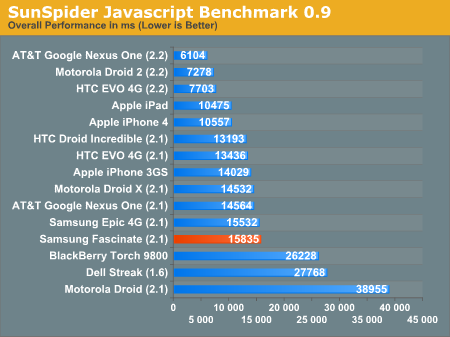

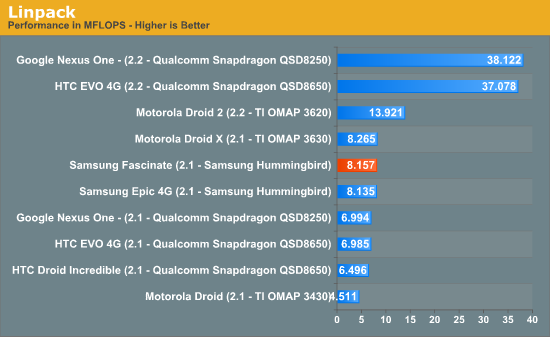
As an aside, I talked in the Droid 2 article about how I didn't quite understand why Linpack performance on Android 2.2 on the OMAP 3620 SoC wasn't what I expected it to be. The comparison I was using was to all the smartphones I had previously seen with Android 2.2 - all of which were Qualcomm Snapdragon SoC based with Scorpion CPUs at the core. The Droid 2 was my first encounter with a relatively standard Cortex-A8 running Android 2.2 with the JIT/NEON optimizations.
As some of our readers noted, the reason that Linpack performance on the Droid 2 isn't as high is simple - Scorpion has faster FPU performance due to a 128 bit SIMD FPU datapath compared to Cortex-A8's 64 bit implementation. Both FPUs process the same SIMD-style instructions, the Scorpion just happens to be able to do twice as much, or optionally turn off half the datapath to save power.
The reason I bring this up is that we won't see as dramatic a change in benchmarks that are FPU/NEON heavy moving from Android 2.1 to 2.2 on the Fascinate. Modest gains are in order all around, but not the dramatic floating point performance boost that really doesn't translate into huge performance gains elsewhere.
I've also been doing the regular suite of page loading tests. Though the Fascinate lacks Flash and the faster browser that 2.2 brings, it renders pretty quickly:
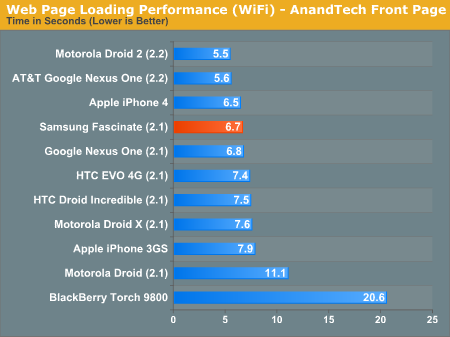
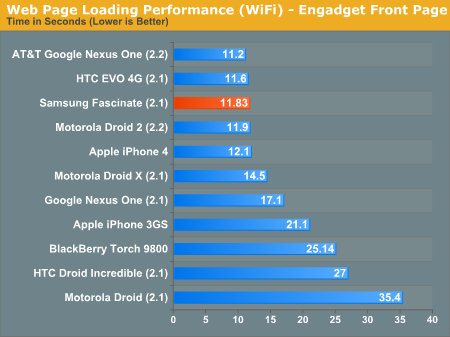










73 Comments
View All Comments
chemist1 - Tuesday, October 5, 2010 - link
kmmantey: Thanks for your comment. I agree audio quality does change with various factors. However, I would say that does not preclude it being of importance, nor being rateable. [ As softdrinkviking said below, one can do an "all things being equal" test.] Yes, various factors can degrade audio; but if you start with really good audio performance then, as you lose quality, at least you're losing from a higher starting point.I think saying "no one cares that much about call quality" is too strong. Granted, most may not care as much as me :). But, even in a mainstream publication like Consumer Reports, voice quality is listed as third among the 11 criteria they use in ranking smart phones (and I think CR has a pretty good bead on what its readership cares about).
More importantly, what should be important here is not what most care about, but rather what we, as presumably more informed and discriminating consumers ;), would find desirable. And I believe that many of us —perhaps even you!—would find a phone that provides significantly better audio quality more pleasing to use.
awaken688 - Wednesday, October 6, 2010 - link
I have to disagree Kmmatney. In fact, in the Droid 2 article I made a similar comment to Brian. For those of us with poor experiences with phones (using the phone part), making sure we get a strong quality phone for phone calls is very important. I want to know that in my car driving on the highway, I can hear someone clearly (is the volume level adequate). That if I am forced to turn it up to the highest volume, it doesn't have distortion. Things of that nature. I know Brian said he is working on it, so I will wait.Brian,
In the meantime, I'd still even appreciate a slightly unscientific test. Take the phone in your car on the same highway at a set speed. Call a recording (make sure it on par with an average human conversation, maybe even quieter to simulate a quiet speaker). Call a friend who can play a recording from a PC at a set volume/distance from a constant phone to simulate those loud and quiet talkers. I'm sure you will think of something. As long as you state it is a placeholder and unscientific, most of the people will completely understand. I'm sure you will have those 1 or 2 idiots post a comment complaining, but don't worry about them. There are many more of us who comment rarely and read daily.
MGSsancho - Tuesday, October 5, 2010 - link
set up your own cell site and connect to that? then make your own phone server with asterick and connect to that? thats a massive about of work dude or see if anyone have mad an app that can poll the codec info using the api? this guy made hos own cell site for 2G but might work on 3G http://www.tombom.co.uk/blog/ if you said you have played with cdma codecs then ill assume you know how to use asterisk lolthere are various ways but i think can think might be better. use a really good mic and take a recording from the sidewalk where you take video from and from other busy/common places, then use those audio files for testing. setup an audio chamber with a speaker playing those recordings. then use a directional mic really close to the speaker of the phone and do analysis on that. make the whole box out of foam so wireless signal doesn't get distorted. you can later intentionally weaker the wireless signal and record how the voice quality drops if you like. This way we can see what the phone sounds like at a club, classroom, sidewalk, store, high winds etc. too shorten this up, get controlled recordings, set up phones in a controlled box then use signal analysis on what comes out of the phones line-out/speaker.
Good Luck
Samoht - Tuesday, October 5, 2010 - link
This is really starting to worry me. Why do these carriers keep messing up good phones?I know that they are trying to differentiate themselves but crippling a product like this is not good business.
And this is on top of the skins from Samsung/HTC/SonyEricsson.
I really hope Google will realise that they need to raise the bar again and make a vanilla phone with gingerbread (tasty :-).
xype - Tuesday, October 5, 2010 - link
"Wait another 6 - 8 months, and you'll probably have something even better than both of these to choose from"So the iPhone _is_ coming to Verizon! :P
FATCamaro - Tuesday, October 5, 2010 - link
Haha. My thoughts exactly...strikeback03 - Tuesday, October 5, 2010 - link
Um, no, that would be something worse. 6-8 months should bring definite timeframes to LTE and A9 processor rollout, if not functional phones already.metafor - Tuesday, October 5, 2010 - link
"As some of our readers noted, the reason that Linpack performance on the Droid 2 isn't as high is simple - Scorpion has faster FPU performance due to a 128 bit SIMD FPU datapath compared to Cortex-A8's 64 bit implementation. Both FPUs process the same SIMD-style instructions, the Scorpion just happens to be able to do twice as much, or optionally turn off half the datapath to save power."That's unlikely the reason. NEON requires vectorized code which -- to my knowledge -- the Dalvik JIT doesn't do on-the-fly. Hell, even Intel's best efforts at auto-vectorization doesn't really cause huge improvements unless your data and loops were already formatted for SIMD operation.
That being said, we don't know how well Scorpion does on normal VFP instructions. It could be that there are some significant improvements over the standard A8 for those as well.
JimmiG - Tuesday, October 5, 2010 - link
Surprised about the rather poor battery life, as the device both has a bigger battery than the Nexus One and sports a 45nm custom SoC vs the older 65nm Snapdragon used in the N1 and others. I really expected the new generation of 45nm SoCs to excel in terms of battery life, especially after seeing the iPhone4 results. But it seems the iPhone4 battery life come down to software optimizations rather than more efficient hardware...This is something Google really needs to work on, since it seems to be a software issue. Before Android went mainstream, battery life of the iPhone (3G, 3GS) wasn't even considered that great. Now it's the gold standard for smart phones... Nearly all Android devices are in the same ballpark of around 4 hours or less of 3G browsing time, with the iPhone4 and even 3GS lasting several hours longer.
DroidUser - Tuesday, October 5, 2010 - link
I've got an i9000. The battery life issue is a major issue for me particularly during the weekends when I'm not sitting at my desk. Even compared to the original iPhone I had before the battery is poor in a couple of ways:2 hours regular web browsing uses about 80% battery life (its hard to tell from the icon). After this some features will not operate (e.g. camera and sometimes making calls). So its a lame-duck phone with <20% battery and in reality you'll be wanting to re-charge it after ~2 hours playing with it.
Re-charging it from empty takes (approx) 2.5 hours from the mains and 3.5 hours from my PCs USB port. My iPhone would re-charge from empty in about 45 min on the mains. That's a lot of extra time that my phone is out of action. The percentage of missed calls I have has gone way up.
I don't understand why AnandTech doesn't have a metric to measure charge time. Its probably the easiest of all tests!